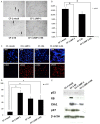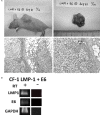Dual expression of Epstein-Barr virus, latent membrane protein-1 and human papillomavirus-16 E6 transform primary mouse embryonic fibroblasts through NF-κB signaling
- PMID: 24966902
- PMCID: PMC4069875
Dual expression of Epstein-Barr virus, latent membrane protein-1 and human papillomavirus-16 E6 transform primary mouse embryonic fibroblasts through NF-κB signaling
Abstract
The prevalence of Epstein-Barr virus (EBV) and high-risk human papilloma virus (HPV) infections in patients with oral cancer in Okinawa, southwest islands of Japan, has led to the hypothesis that carcinogenesis is related to EBV and HPV co-infection. To explore the mechanisms of transformation induced by EBV and HPV co-infection, we analyzed the transformation of primary mouse embryonic fibroblasts (MEFs) expressing EBV and HPV-16 genes, alone or in combination. Expression of EBV latent membrane protein-1 (LMP-1) alone or in combination with HPV-16 E6 increased cell proliferation and decreased apoptosis, whereas single expression of EBV nuclear antigen-1 (EBNA-1), or HPV-16 E6 did not. Co-expression of LMP-1 and E6 induced anchorage-independent growth and tumor formation in nude mice, whereas expression of LMP-1 alone did not. Although the singular expression of these viral genes showed increased DNA damage and DNA damage response (DDR), co-expression of LMP-1 and E6 did not induce DDR, which is frequently seen in cancer cells. Furthermore, co-expression of LMP-1 with E6 increased NF-κB signaling, and the knockdown of LMP-1 or E6 in co-expressing cells decreased cell proliferation, anchorage independent growth, and NF-κB activation. These data suggested that expression of individual viral genes is insufficient for inducing transformation and that co-expression of LMP-1 and E6, which is associated with suppression of DDR and increased NF-κB activity, lead to transformation. Our findings demonstrate the synergistic effect by the interaction of oncogenes from different viruses on the transformation of primary MEFs.
Keywords: E6; LMP-1; NF-κB; co-expression; primary mouse embryonic fibroblast; transformation.
Figures






Similar articles
-
Co-expression of low-risk HPV E6/E7 and EBV LMP-1 leads to precancerous lesions by DNA damage.BMC Cancer. 2021 Jun 10;21(1):688. doi: 10.1186/s12885-021-08397-0. BMC Cancer. 2021. PMID: 34112111 Free PMC article.
-
Sequence variations between two Epstein-Barr virus LMP 1 variants have no effect on the activation of NF-kappaB activity.DNA Cell Biol. 1997 Nov;16(11):1311-9. doi: 10.1089/dna.1997.16.1311. DNA Cell Biol. 1997. PMID: 9407003
-
Repression of Smad-dependent transforming growth factor-beta signaling by Epstein-Barr virus latent membrane protein 1 through nuclear factor-kappaB.Int J Cancer. 2003 Jul 10;105(5):661-8. doi: 10.1002/ijc.11146. Int J Cancer. 2003. PMID: 12740915
-
Epstein-Barr virus latent genes.Exp Mol Med. 2015 Jan 23;47(1):e131. doi: 10.1038/emm.2014.84. Exp Mol Med. 2015. PMID: 25613728 Free PMC article. Review.
-
Potential Role of Epstein-Barr Virus in Oral Potentially Malignant Disorders and Oral Squamous Cell Carcinoma: A Scoping Review.Viruses. 2022 Apr 13;14(4):801. doi: 10.3390/v14040801. Viruses. 2022. PMID: 35458531 Free PMC article.
Cited by
-
The Prevalence of Epstein-Barr Virus in Normal, Premalignant, and Malignant Uterine Cervical Samples in Iran.Intervirology. 2024;67(1):64-71. doi: 10.1159/000538734. Epub 2024 Apr 15. Intervirology. 2024. PMID: 38621370 Free PMC article.
-
Comparative Analysis of Non-viral Transfection Methods in Mouse Embryonic Fibroblast Cells.J Biomol Tech. 2017 Jul;28(2):67-74. doi: 10.7171/jbt.17-2802-003. Epub 2017 Apr 29. J Biomol Tech. 2017. PMID: 28507462 Free PMC article.
-
How Does Epstein-Barr Virus Interact With Other Microbiomes in EBV-Driven Cancers?Front Cell Infect Microbiol. 2022 Feb 23;12:852066. doi: 10.3389/fcimb.2022.852066. eCollection 2022. Front Cell Infect Microbiol. 2022. PMID: 35281433 Free PMC article. Review.
-
The human papillomavirus E6 protein targets apoptosis-inducing factor (AIF) for degradation.Sci Rep. 2020 Aug 26;10(1):14195. doi: 10.1038/s41598-020-71134-3. Sci Rep. 2020. PMID: 32848167 Free PMC article.
-
The Role of Coinfections in the EBV-Host Broken Equilibrium.Viruses. 2021 Jul 19;13(7):1399. doi: 10.3390/v13071399. Viruses. 2021. PMID: 34372605 Free PMC article. Review.
References
MeSH terms
Substances
LinkOut - more resources
Full Text Sources
Research Materials
